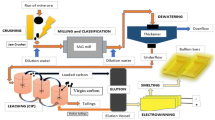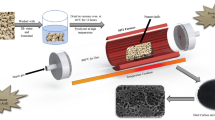Abstract
Good cathode quality in copper electrorefining depends on maintaining an optimum level of glue and other leveling reagents in the electrolyte. A rapid electrochemical method has been developed for measuring the concentration of active glue in the electrolyte. It is based on the fact that glue strongly influences the polarization (currentvs potential) curve of a copper cathode in such electrolyte. The polarization curve is also influenced by the concentrations of copper, nickel, and thiourea (another leveling reagent) in the solution; the concentrations of these substances also can vary. With the present method a cathodic scan curve of a copper electrode is measured in the fresh, test electrolyte and again after the electrolyte is heated such as to destroy the active glue by hydrolysis; the heating does not affect the thiourea, Cu+2 or Ni+2 ions. The glue concentration is determined from the difference in the scan curves for the fresh and heated electrolytes. The difference may be quantified if needed by making standard glue additions to the cooked electrolyte and measuring the corresponding scan curves.
Similar content being viewed by others
References
A. Butts:Copper, The Science and Technology of the Metal, Its Alloys and Compounds, pp. 203–04, Hafner Publishing Co., New York, N. Y., 1970.
Private communications with Professor F. E. Rizzo, The University of Texas at El Paso, El Paso, Texas, 1973.
D. R. Turner and G. R. Johnson:J. Electrochem. Soc., 1962, vol. 109, pp. 798–804.
S. S. Kruglikov, Y. D. Gamburg, and N. T. Kudryavtsev:Electrochim. Acta, 1967, vol. 12, pp. 1129–33.
R. Lindstrom and S. Wallden: inInternational Symposium on Hydrometallurgy, held February 25 to March 1, 1973, pp. 111–26, The American Institute of Mining, Metallurgical and Petroleum Engineers, Inc., New York, N. Y., 1973.
Ref. 1, pp. 177–80.
H. S. Jennings and F. E. Rizzo:Met. Trans., 1973, vol. 4, pp. 921–26.
Author information
Authors and Affiliations
Additional information
The methods given by Refs. 2 and 4 are useful, despited the limitations stated, for tankhouse application in which Ni+2 and Cu+2 ion concentrations change very little or are monitored separately.
Rights and permissions
About this article
Cite this article
Andersen, T.N., Budd, R.D. & Strachan, R.W. A rapid electrochemical method for measuring the concentration of active glue in copper refinery electrolyte which contains thiourea. Metall Trans B 7, 333–338 (1976). https://doi.org/10.1007/BF02652702
Received:
Issue Date:
DOI: https://doi.org/10.1007/BF02652702




